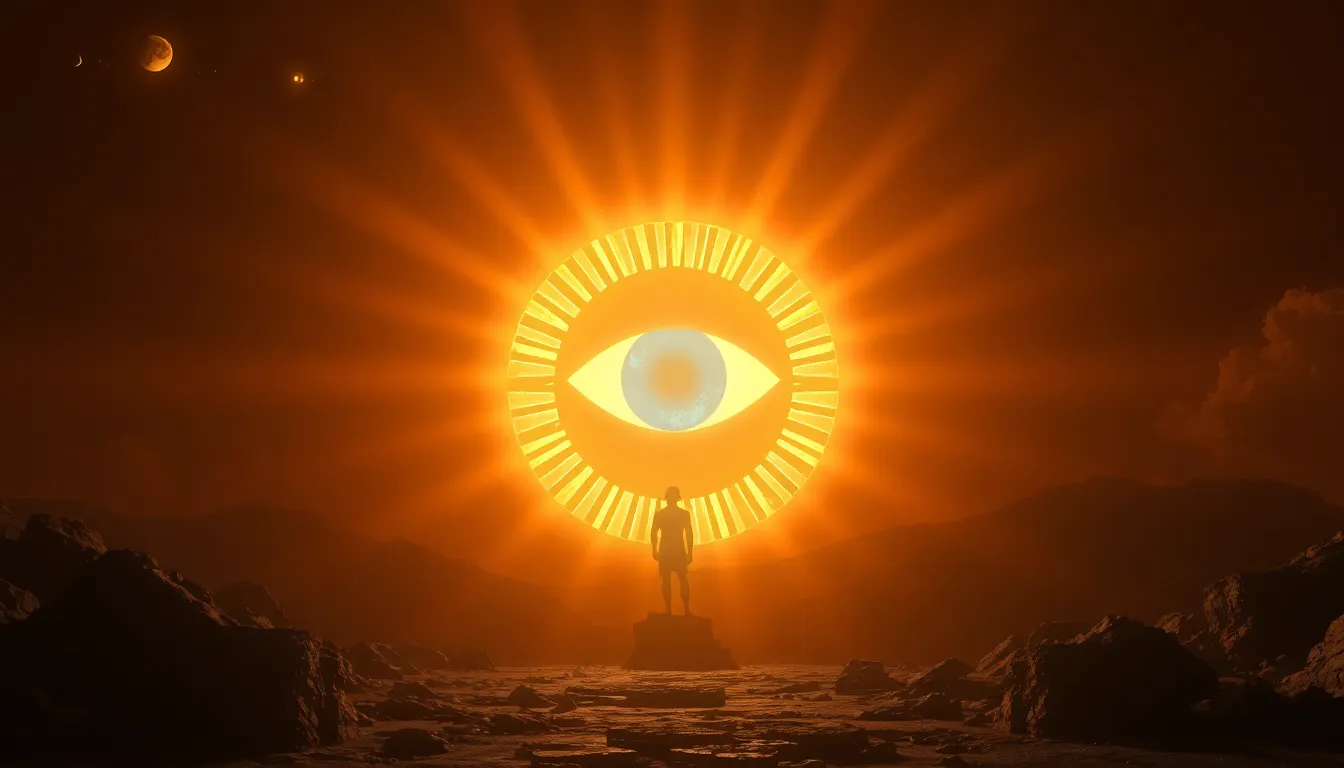The Myth of Ra’s Eye: The Sun as a Protective Force
I. Introduction
In the pantheon of ancient Egyptian mythology, few deities hold as much significance as Ra, the sun god. Revered as the creator of life and the source of light, Ra embodies not just the sun itself but also the principles of order and protection. Among the symbols associated with him, Ra’s Eye, often depicted as a powerful protective force, plays a crucial role in the mythology and spiritual beliefs of ancient Egyptians. This article aims to explore the intricate myth of Ra’s Eye, its implications for ancient Egyptian society, and its lasting legacy.
II. Historical Context of Ra and His Eye
Ra’s origins can be traced back to the early dynastic period of ancient Egypt, where he was initially worshipped as a sun deity. As the religious landscape evolved, so did the complexity of Ra’s character, merging with other deities and absorbing their attributes.
- Origins of Ra: Initially depicted as a falcon-headed man, Ra’s symbolism evolved, representing not only the sun but also kingship and power.
- Symbolism of the Sun: In many ancient cultures, the sun was viewed as a divine force. It was associated with life, growth, and nourishment, integral to agriculture and survival.
- Myth Evolution: Over centuries, the stories surrounding Ra and his Eye transformed, adapting to the changing beliefs and societal needs of the Egyptians.
III. The Myth of Ra’s Eye Explained
Ra’s Eye is often depicted as the ‘Eye of Horus’ or the ‘Udjat,’ symbolizing protection, royal power, and good health. The Eye embodies the sun’s rays, signifying both illumination and vigilance.
- Key Representations: Ra’s Eye is visually represented as a stylized eye with intricate markings. It symbolizes the watchful gaze of the sun, overseeing both the living and the dead.
- Legends: One of the most famous legends involves Ra sending his Eye to search for his lost daughter, Hathor. This journey represents the protective nature of Ra’s Eye, always vigilant and seeking to restore harmony.
- Transformation into Wadjet: In some interpretations, Ra’s Eye evolved into the goddess Wadjet, who became a protector of the pharaohs and the nation, symbolizing the fierce and nurturing aspects of femininity.
IV. Ra’s Eye as a Protector in Egyptian Beliefs
The protective qualities attributed to Ra’s Eye are deeply embedded in the funerary practices and beliefs about the afterlife in ancient Egypt.
- Protective Qualities: Ra’s Eye is believed to ward off evil and provide safety. It was essential in ensuring a safe passage to the afterlife.
- Funerary Practices: The Eye played a significant role in tomb inscriptions and artifacts, designed to safeguard the deceased during their journey beyond death.
- Amulets: Various amulets were created in the shape of Ra’s Eye, believed to provide protection and health to the wearer, reflecting the enduring belief in its power.
V. The Dual Nature of Ra’s Eye
While Ra’s Eye is primarily seen as a protective force, it also embodies duality, representing both creation and destruction, light and darkness.
- Balance of Creation and Destruction: Ra’s Eye symbolizes the cyclical nature of life and death, emphasizing that creation often comes from destruction.
- Concept of Ma’at: The principle of Ma’at, representing truth and cosmic order, is integral to understanding Ra’s role. Ra’s Eye is depicted as maintaining this balance, ensuring harmony in the universe.
- Interplay of Light and Darkness: In Egyptian mythology, light and darkness are not opposites but complementary forces, with Ra’s Eye embodying this complex relationship.
VI. Ra’s Eye in Modern Interpretations
The influence of Ra’s Eye extends beyond ancient times, finding relevance in modern spirituality, art, and literature.
- Contemporary Spirituality: Many modern spiritual practices draw inspiration from Ra’s Eye, using it as a symbol of protection, healing, and enlightenment.
- Art and Literature: Ra’s Eye has inspired countless artistic representations and literary works, symbolizing the eternal quest for power and protection.
- Relevance Today: In today’s discussions about personal empowerment and safety, the essence of Ra’s Eye resonates, reminding us of the importance of vigilance and protection in our lives.
VII. Comparative Analysis with Other Cultures
The archetype of the protective eye can be found in various cultures, revealing universal themes in mythology.
- Similar Myths: In Greek mythology, the concept of the all-seeing eye echoes through the stories of gods like Helios, while in Norse mythology, the watchful gaze of Odin serves a similar purpose.
- Cross-Cultural Symbols: Many cultures utilize symbols like the evil eye to ward off misfortune, showcasing a shared understanding of the need for protection.
- Guardianship in Mythology: The themes of guardianship and protective forces are prevalent across civilizations, reflecting humanity’s collective desire for safety and order.
VIII. Conclusion
Ra’s Eye stands as a powerful symbol of protection, illuminating the deep-rooted beliefs of ancient Egyptians about life, death, and the cosmos. Its legacy continues to influence modern spirituality, art, and cultural discussions about power and safety. Understanding the myth of Ra’s Eye allows us to appreciate the intricate ways in which ancient societies expressed their values and beliefs, reinforcing the idea that myths serve as a lens through which we can explore the human experience across time and cultures.




